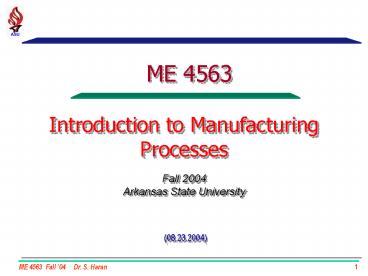Sand Casting Overview - PowerPoint PPT Presentation
1 / 13
Title:
Sand Casting Overview
Description:
The following simple sand casting procedure is a split pattern ... runner bar with its extension and the ingate is cut into the sand surface and smoothed off. ... – PowerPoint PPT presentation
Number of Views:181
Avg rating:3.0/5.0
Title: Sand Casting Overview
1
ME 4563
Introduction to Manufacturing Processes
Fall 2004 Arkansas State University
(08.23.2004)
2
Sand Casting A Simple Example
- The following simple sand casting procedure is
a split pattern which forms half a hand-brake
drum for a scale model steam truck - This is a basic sand casting procedure to be
followed for the lab exercise - Duration approx 4 weeks.
- For the first week (details to be readied by
August 30th) - Each group must select an item to be cast
- Plan a strategy as to how you will proceed
- Modify the casting steps as is practically
required - Give me your list of materials required
- You will not use molten metal - so improvise
- Any questions discuss with me
3
Sand Casting
1. On the left is the top (cope) and on the right
is the bottom (drag) molding boxes.
2. The half-pattern is placed on the base plate
ready to take the sand.
4
Sand Casting
- Once the ramming is complete and the surface is
leveled, the box is carefully turned over on its
back. - The exposed surface of the pattern is clearly
shown
3. The sand is tipped in the box and rammed
down. The ramming tool is shown in front. The
wedged end is used for the first ramming and the
flat end is used on the second ramming.
5
Sand Casting
5. The surface is dusted with parting powder and
the other half of the pattern is placed on the
first half still embedded in the sand. The top
box is placed on the bottom box and skewed
clockwise against the registration pegs.
6
Sand Casting
6. The runner (right tube) is pushed into the
sand in the bottom box and the riser (left tube)
is placed onto the pattern hub. The tubes are
held in place while the sand is shoveled in.
7
Sand Casting
- The sand is rammed down and leveled off. The
runner basin is cut into the top surface of the
sand at this stage. - The boxes can now be separated (very carefully).
8
Sand Casting
- The box halves with the pattern still in place.
- The white surface is the parting powder (talc).
- The small hole in the sand is the well left by
the runner tube.
9
Sand Casting
9. The pattern is removed by lightly tapping it.
The runner bar with its extension and the
ingate is cut into the sand surface and smoothed
off. At this stage the boxes are put back
together.
10
Sand Casting
- The completed mould ready to pour in the molten
cast iron. - The iron weights help keep the boxes
together during the pouring process.
11
Sand Casting
- The molten cast iron being poured into the mould.
- The slag is kept away from the pouring lip.
12
Sand Casting
- The metal has cooled.
- Note the runner basin on the right and the riser
opening to the left.
13
Sand Casting
- The casting is removed from the sand and looks
like this. - The riser and sprue are cut off the main casting.































